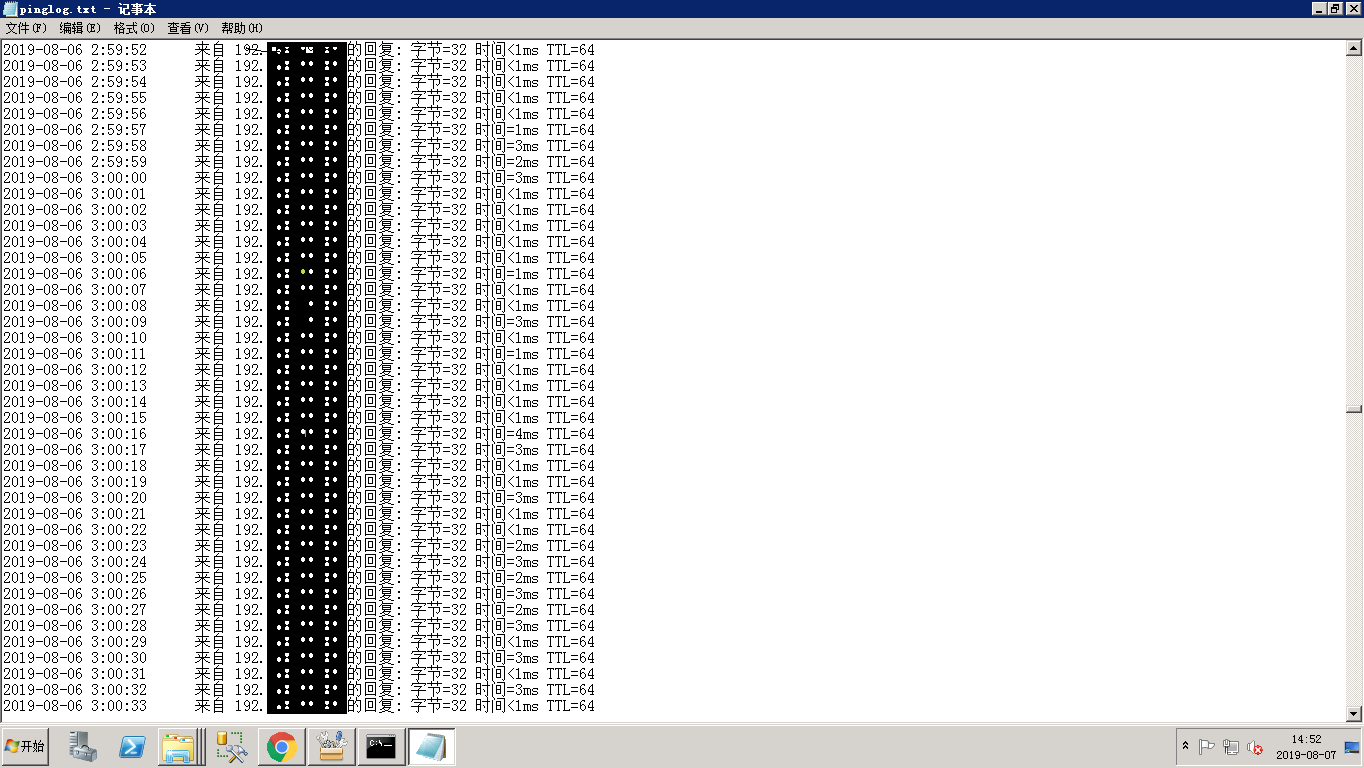在给客户做运维服务期间,发现了一个奇怪的现象:备份系统(第三方国产)告警日志显示,每天晚上备份服务器的客户端在3点左右离线然后上线,再离线再上线,每晚两次,很是诡异。

联系了厂家技术支持,前后花了两天时间也没给出个答案,一会让我测试网络是否连接正常,一会让我重启客户端服务试试,最终不了了之,很不专业,体验极差。
我通过长ping生成日志,发现在3点左右网络是正常的,没有出现丢包现象。

思索着既然网络没有问题,查看系统日志在3点左右没任何异常日志,就猜测是不是端口异常,如何实时监听要做备份的客户端跟备份服务器制定端口连接情况?网上搜索了很久找到了TCPing这个工具,很好用。做个记录,也分享给大家。
Windows版本下载地址:https://elifulkerson.com/projects/tcping.php
参数如下:
NAME
tcping - simulate "ping" over tcp by establishing a connection to network hosts.
Measures the time for your system to [SYN], receive the target's [SYN][ACK] and send [ACK]. Note that the travel time for
the last ACK is not included - only the time it takes to be put on the wire a tthe sending end.
SYNOPSIS
tcping [-tdsvf46] [-i interval] [-n times] [-w interval] [-b n] [-r times][-j depth] [--tee filename] [-f] destination [port]
DESCRIPTION
tcping measures the time it takes to perform a TCP 3-way handshake (SYN, SYN/ACK, ACK) between itself and a remote host.
The travel time of the outgoing final ACK is not included, only the (minimal) amount of time it has taken to drop it on
the wire at the near end. This allows the travel time of the (SYN, SYN/ACK) to approximate the travel time of the
ICMP (request, response) equivalent.
OPTIONS
-4 Prefer using IPv4
-6 Prefer using IPv6
-t ping continuously until stopped via control-c
-n count
send _count_ pings and then stop. Default 4.
-i interval
Wait _interval_ seconds between pings. Default 1. Decimals permitted.
-w interval
Wait _interval_ seconds for a response. Default 2. Decimals permitted.
-d include date and time on every output line
-f Force sending at least one byte in addition to making the connection.
-g count
Give up after _count_ failed pings.
-b type
Enable audible beeps.
'-b 1' will beep "on down". If a host was up, but now its not, beep.
'-b 2' will beep "on up". If a host was down, but now its up, beep.
'-b 3' will beep "on change". If a host was one way, but now its the other, beep.
'-b 4' will beep "always".
-c only show output on a changed state
-r count
Every _count_ pings, we will perform a new DNS lookup for the host in case it changed.
-s Exit immediately upon a success.
-v Print version and exit.
-j Calculate jitter. Jitter is defined as the difference between the last response time and the historical average.
-js depth
Calculate jitter, as with -j but with an optional _depth_ argument specified. If _depth_ is specified tcping will
use the prior _depth_ values to calculate a rolling average.
--tee _filename_
Duplicate output to the _filename_ specified. Windows can still not be depended upon to have a useful command line
environment. Don't tease me, *nix guys.
--append
When using --tee, append to rather than overwrite the output file.
--file
Treat the "destination" option as a filename. That file becomes a source of destinations, looped through on a
line by line basis. Some options don't work in this mode and statistics will not be kept.
destination
A DNS name, an IP address, or (in "http" mode) a URL.
Do not specify the protocol ("http://") in "http" mode. Also do not specify server port via ":port" syntax.
For instance: "tcping http://www.elifulkerson.com:8080/index.html" would fail
Use the style: "tcping www.elifulkerson.com/index.html 8080" instead.
port
A numeric TCP port, 1-65535. If not specified, defaults to 80.
--header
include a header with the command line arguments and timestamp. Header is implied if using --tee.
HTTP MODE OPTIONS
-h Use "http" mode. In http mode we will attempt to GET the specified document and return additional values including
the document's size, http response code, kbit/s.
-u In "http" mode, include the target URL on each output line.
--post Use POST instead of GET in http mode.
--head Use HEAD instead of GET in http mode.
--get Shorthand to invoke "http" mode for consistency's sake.
--proxy-server _proxyserver_
Connect to _proxyserver_ to request the url rather than the server indicated in the url itself.
--proxy-port _port_
Specify the numeric TCP port of the proxy server. Defaults to 3128.
--proxy-credentials username:password
Specify a username:password pair which is sent as a 'Proxy-Authorization: Basic' header.
RETURN VALUE
tcping returns 0 if all pings are successful, 1 if zero pings are successful and 2 for mixed outcome.
BUGS/REQUESTS
Please report bugs and feature requests to the author via contact information on http://www.elifulkerson.com
AVAILABILITY
tcping is available at http://www.elifulkerson.com/projects/tcping.php
|
翻译如下:
|
描述
-6,优先使用IPv6 -h,使用http模式 -t,让命令持续运行,直到使用ctrl + c指令退出 -n 数字,发送命令的次数,默认4次 -i 数字,发送ping命令的时间间隔,默认1s,可以为小数 -w 数字,等待响应的时间间隔,默认2s,可以为小数 -d,使输出的每一行显示时间和日期 -f,强制ping命令至少发送一个比特(byte) -g 数字,失败指定次就放弃(注意默认是80端口,若其他端口没开也算失败) -b 数字,开启蜂鸣器,参数4会一直响铃 -c,只显示改变的信息(ping时间很短一般不会改变) -r 数字,每发送指定个数据包,就重新查找主机一次(通过DNS或路由查找) -s,ping通就立即退出 -u,与-h命令连用,每一行输出目标的url -v,显示版本信息 -j,使用默认的方法,求ping的均值减小波动,网络有一定的不稳定性时,用此参数可以减小波动 -js 数字,用指定个实例求平均值减小波动,使用这个参数,系统会tcping 指定次,然后求出平均值作为一次结果显示,减小波动 –tee file_path,将结果输出到指定位置,tcping –tee /data/test.txt192.168.0.100,会把ping的结果保存在/data下的test文件中 –file,从文件中获得ping的来源;在/data下新建一个test.txt文件,并输入要tcping的所有ip或域名,一行一个,然后执行命令tcping –file /data/test.txt,就会依次tcping文件中指定的地址 destination,可以是DNS地址、IP地址、URL(需要使用-h,http模式)。使用http模式时,不要加https//或:port,例如:tcping http://www.elifulkerson.com:8080/index.html就会失败,使用tcping www.elifulkerson.com/index.html 8080就会成功 port 数字,指定tcp端口(1-65535),如果不指定,默认是80 –header,在头部显示时间和日期,与–tee显示的格式差不多 –block,tcping不通的等待时间,默认是20秒(很长)。–block可以把-w参数冲突掉 ,例如tcping --block www.baiu.com网址不正确,显然tcpping不通,默认会等待20s 。 tcping -w 0.5 –block www.baiu.com还是会等20s,而不是0.5s,因为–block选项会把-w选项冲突掉。 HTTP模式选项 –head,在http模式中,使用head方法 –get Shorthand to invoke “http” mode for consistency’s sake. –proxy-server,指定代理服务 –proxy-port,指定代理服务端口 –proxy-credentials username:password,使用代理的安全验证,需要输入用户名和密码 返回值 测试:tcping 200.209.200.15 21 |
我主要用的功能是长ping和输出存档:tcping.exe -t -d --tee d:/tcpping.log 192.168.**.** 9952
自动保存到D盘目录。